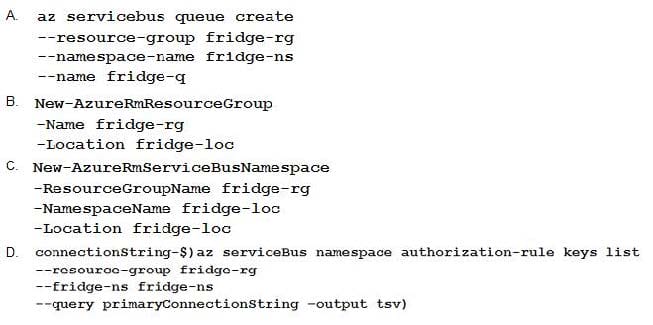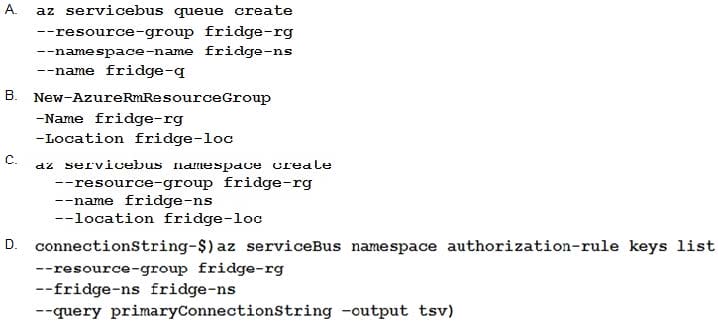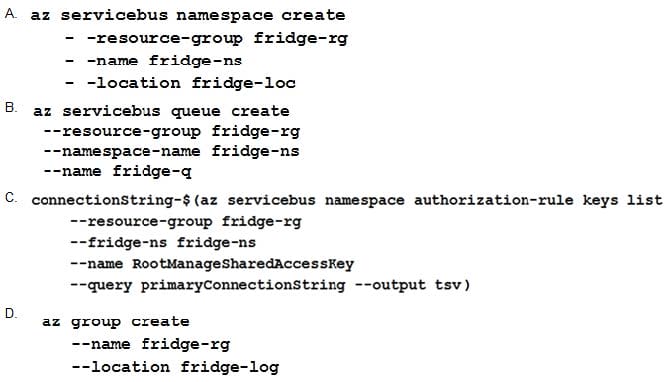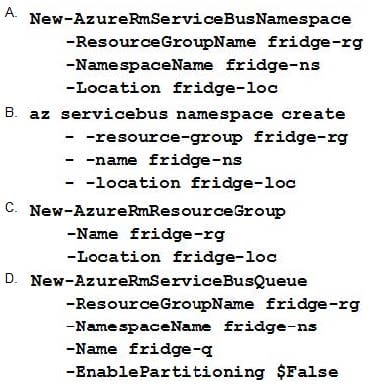Exam Details
Exam Code
:AZ-204Exam Name
:Developing Solutions for Microsoft AzureCertification
:Microsoft CertificationsVendor
:MicrosoftTotal Questions
:532 Q&AsLast Updated
:
Microsoft Microsoft Certifications AZ-204 Questions & Answers
-
Question 251:
You are building a loyalty program for a major snack producer. When customers buy a snack at any of 100 participating retailers the event is recorded in Azure Event Hub. Each retailer is given a unique identifier that is used as the primary
identifier for the loyalty program.
Retailers must be able to be added or removed at any time. Retailers must only be able to record sales for themselves.
You need to ensure that retailers can record sales.
What should you do?
A. Use publisher policies for retailers.
B. Create a partition for each retailer.
C. Define a namespace for each retailer.
-
Question 252:
You are developing an online game that includes a feature that allows players to interact with other players on the same team within a certain distance. The calculation to determine the players in range occurs when players move and are
cached in an Azure Cache for Redis instance.
The system should prioritize players based on how recently they have moved and should not prioritize players who have logged out of the game.
You need to select an eviction policy.
Which eviction policy should you use?
A. allkeys-Iru
B. volatile-Iru
C. allkeys-lfu
D. volatile-ttl
-
Question 253:
A company is developing a solution that allows smart refrigerators to send temperature information to a central location. You have an existing Service Bus.
The solution must receive and store messages until they can be processed. You create an Azure Service Bus instance by providing a name, pricing tier, subscription, resource group, and location.
You need to complete the configuration.
Which Azure CLI or PowerShell command should you run?

A. Option A
B. Option B
C. Option C
D. Option D
-
Question 254:
A company is developing a solution that allows smart refrigerators to send temperature information to a central location. You have an existing Service Bus.
The solution must receive and store message until they can be processed. You create an Azure Service Bus Instance by providing a name, pricing tier, subscription, resource group, and location.
You need to complete the configuration.
Which Azure CLI or PowerShell command should you run?

A. Option A
B. Option B
C. Option C
D. Option D
-
Question 255:
A company is developing a solution that allows smart refrigerators to send temperature information to a central location. You have an existing Service Bus.
The solution must receive and store messages until they can be processed. You create an Azure Service Bus instance by providing a name, pricing tier, subscription, resource group, and location.
You need to complete the configuration.
Which Azure CLI or PowerShell command should you run?

A. Option A
B. Option B
C. Option C
D. Option D
-
Question 256:
A company is developing a solution that allows smart refrigerators to send temperature information to a central location. You have an existing Service Bus.
The solution must receive and store messages until they can be processed. You create an Azure Service Bus instance by providing a name, pricing tier, subscription, resource group, and location.
You need to complete the configuration.
Which Azure CLI or PowerShell command should you run?

A. Option A
B. Option B
C. Option C
D. Option D
-
Question 257:
A company is developing a solution that allows smart refrigerators to send temperature information to a central location. You have an existing Service Bus.
The solution must receive and store messages until they can be processed. You create an Azure Service Bus instance by providing a name, pricing tier, subscription, resource group, and location.
You need to complete the configuration.
Which Azure CLI or PowerShell command should you run?

A. Option A
B. Option B
C. Option C
D. Option D
-
Question 258:
You are developing a Java application to be deployed in Azure. The application stores sensitive data in Azure Cosmos DB. You need to configure Always Encrypted to encrypt the sensitive data inside the application. What should you do first?
A. Create a customer-managed key (CMK) and store the key in a new Azure Key Vault instance.
B. Create an Azure AD managed identity and assign the identity to a new Azure Key Vault instance.
C. Create a data encryption key (DEK) by using the Azure Cosmos DB SDK and store the key in Azure Cosmos DB.
D. Create a new container to include an encryption policy with the JSON properties to be encrypted.
-
Question 259:
A company is developing a solution that allows smart refrigerators to send temperature information to a central location.
The solution must receive and store messages until they can be processed. You create an Azure Service Bus instance by providing a name, pricing tier, subscription, resource group, and location.
You need to complete the configuration.
Which Azure CLI or PowerShell command should you run?

A. Option A
B. Option B
C. Option C
D. Option D
-
Question 260:
You develop an ASP.NET Core app that uses Azure App Configuration. You also create an App Configuration containing 100 settings. The app must meet the following requirements:
1.
Ensure the consistency of all configuration data when changes to individual settings occur.
2.
Handle configuration data changes dynamically without causing the application to restart.
3.
Reduce the overall number of requests made to App Configuration APIs.
You must implement dynamic configuration updates in the app.
What are two ways to achieve this goal? Each correct answer presents part of the solution.
NOTE: Each correct selection is worth one point.
A. Increase the App Configuration cache expiration from the default value.
B. Create and implement environment variables for each App Configuration store setting.
C. Decrease the App Configuration cache expiration from the default value.
D. Register all keys in the App Configuration store. Set the refreshAII parameter of the Register method to false.
E. Create and register a sentinel key in the App Configuration store. Set the refreshAII parameter of the Register method to true.
F. Create and configure Azure Key Vault. Implement the Azure Key Vault configuration provider.
Related Exams:
62-193
Technology Literacy for Educators70-243
Administering and Deploying System Center 2012 Configuration Manager70-355
Universal Windows Platform – App Data, Services, and Coding Patterns77-420
Excel 201377-427
Excel 2013 Expert Part One77-725
Word 2016 Core Document Creation, Collaboration and Communication77-726
Word 2016 Expert Creating Documents for Effective Communication77-727
Excel 2016 Core Data Analysis, Manipulation, and Presentation77-728
Excel 2016 Expert: Interpreting Data for Insights77-731
Outlook 2016 Core Communication, Collaboration and Email Skills
Tips on How to Prepare for the Exams
Nowadays, the certification exams become more and more important and required by more and more enterprises when applying for a job. But how to prepare for the exam effectively? How to prepare for the exam in a short time with less efforts? How to get a ideal result and how to find the most reliable resources? Here on Vcedump.com, you will find all the answers. Vcedump.com provide not only Microsoft exam questions, answers and explanations but also complete assistance on your exam preparation and certification application. If you are confused on your AZ-204 exam preparations and Microsoft certification application, do not hesitate to visit our Vcedump.com to find your solutions here.